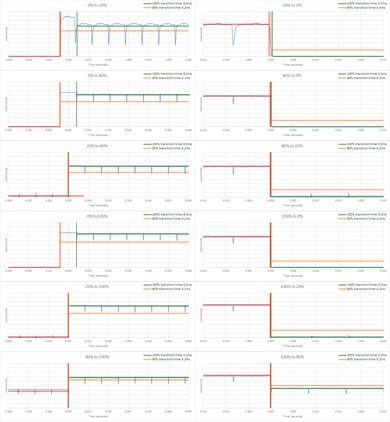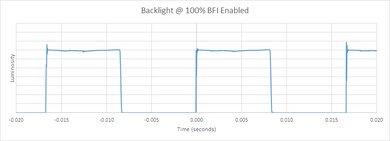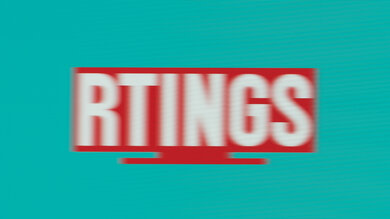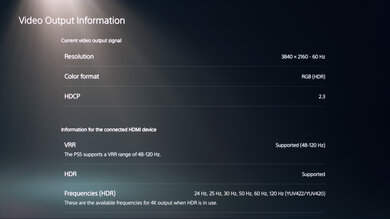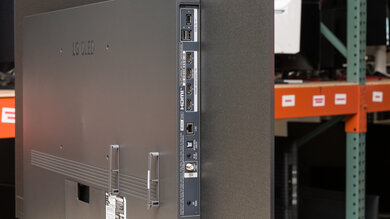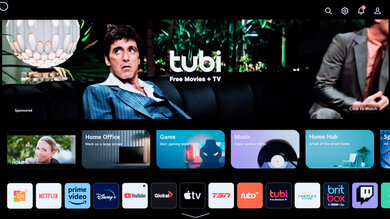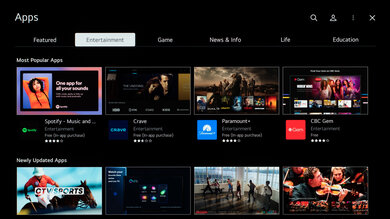The LG C3 OLED is the mid-range model in LG's 2023 OLED lineup, sitting above the entry-level OLED 'B' series LG B3 OLED and below the 'Gallery Style' LG G3 OLED. Aside from the G3's Micro Lens Array (MLA) technology, the C3 comes with everything the G3 does, like the 2023 version of LG's proprietary webOS smart interface and four full HDMI 2.1 bandwidth ports. It also has LG's α9 AI Processor Gen6, which promises improved image processing through LG's Brightness Booster Max and AI Tech technologies, as well as the ability to up-mix 2-channel audio into virtual 7.1.2 channel sound using AI Sound.
Our Verdict
The LG C3 OLED is a remarkable TV overall. The very good brightness in both SDR and HDR makes it well-suited to watching anything, from SDR content to the latest hit movies in HDR. It also has superb reflection handling, so the TV can handle bright rooms or glare without issue. But like almost every OLED on the market, it's better suited for a dark room, where its OLED panel, with its deep inky blacks, truly performs at its best. Its very low input lag makes it a gamer's dream, as your inputs are translated almost instantaneously to the screen, and its superb response time makes it a great choice for any fans of fast-moving content, be it sports or games, as action stays clear and crisp throughout. The TV also supports DTS, making it a fantastic choice for your home entertainment center.
- Fantastic reflection handling.
- Image remains accurate at a wide angle.
- Aggressive ABL can get distracting with large areas of brightness.
The LG C3 OLED is an excellent TV for watching TV shows. It has fantastic reflection handling, and combined with its very good peak brightness in SDR, it can handle bright rooms or rooms with lots of glare. Its viewing angle is superb, so the image remains consistent even when viewing the TV entirely from the side. If a group is sitting around the TV to watch the latest episode of their favorite show, they'll have a great viewing experience no matter where they're sitting. The TV also has very good sharpness processing, so lower-resolution content is upscaled well, and when combined with the panel's excellent low-quality content smoothing, your shows will still look great.
The LG C3 OLED is an amazing TV for watching sports. It has exceptional reflection handling, which is great when watching shows in a room with glare, and the TV gets bright in SDR, so it handles bright rooms well. The TV's viewing angle is superb, so the image remains consistent even when viewing the TV from the side, so those sitting off-center will have a pleasant viewing experience. It has an incredible response time, so motion, like fast-moving players, is crisp and sharp, with no blurring. The TV has very good color uniformity, so when watching sports with large areas of uniform color, like hockey, you won't be distracted by annoying smudges or color variations in the image.
- Fantastic reflection handling.
- Image remains accurate at a wide angle.
- Excellent low-quality content smoothing.
- Aggressive ABL can get distracting with large areas of brightness.
The LG C3 OLED is a fantastic TV to spend your evenings immersed in your favorite games. Enabling Game Mode doesn't noticeably affect image quality, so your games simultaneously look great and feel super responsive due to the TVs incredibly low input lag; your inputs are translated to the on-screen action almost instantly. The TV has fantastic reflection handling, and combined with its very good peak brightness in SDR, this makes it a fantastic OLED for bright rooms or rooms with glare. The response time is exceptionally low, so no matter how fast the action moves, you won't have any blur or ghosting.
- Fantastic reflection handling.
- Very low input lag.
- Impressive gaming features.
- HDMI 2.1 bandwidth on all four ports.
TV is a bit dimmer in Game Mode.
The LG C3 OLED is an excellent TV for watching the latest hit movies. Like all OLEDs, it has incredible contrast, with deep, inky blacks and no blooming around bright highlights. It has very good HDR peak brightness, so bright highlights look great next to the perfect blacks. It also has excellent low-quality content smoothing and very good low-resolution upscaling, so whether you like to watch movies on legacy formats like DVDs or through streaming services like Netflix, your content is free of macro-blocking, and details are preserved. The TV handles judder perfectly, so your movies are judder-free. The TV's color accuracy is excellent, so you don't need to worry about having it calibrated.
- Automatically removes 24p judder from any source.
- Wide color gamut for HDR content.
- Supports DTS audio formats, which is great for DVDs and Blu-rays.
- Excellent low-quality content smoothing.
- Fast response time results in noticeable stutter.
- Colors aren't as bright as pure white.
The LG C3 OLED is an outstanding TV to be blown away by the latest hit games in HDR. The TV has remarkably low input lag with Game Mode on, so games feel super responsive; your inputs almost instantly translate to the on-screen action. The TV can handle all commonly used resolutions, like 1440p @ 120Hz and 4k @ 120Hz. It has fantastic reflection handling, and when combined with the TV's satisfactory HDR brightness in Game Mode, you'll enjoy gaming on the C3 even during the day. Still, it's certainly better suited to playing in a dark room. The response time is exceptionally low, so no matter how fast the action moves, you won't have any blur or ghosting.
- Wide color gamut for HDR content.
- Very low input lag.
- Impressive gaming features.
- HDMI 2.1 bandwidth on all four ports.
- Colors aren't as bright as pure white.
TV is a bit dimmer in Game Mode.
The LG C3 OLED is a fantastic TV for use as a PC monitor but with some caveats. It has a nearly instantaneous response time and incredibly low input lag, so games, or your mouse cursor, are fluid and responsive, with almost no distracting motion blur behind fast-moving objects. Its viewing angle is amazing, so even if you sit in front of the TV, you won't notice any discoloration or dimming at the edges. It gets bright in SDR and has amazing reflection handling, so it'll look great even if your office setup is in a bright room or in front of some windows. Unfortunately, like many TVs, the C3 doesn't use a standard RGB subpixel layout, so text isn't very clear when used as a monitor. Finally, as with all OLEDs, there's a risk of permanent burn-in when exposed to static elements, like the UI elements of a computer desktop.
- Fantastic reflection handling.
- Image remains accurate at a wide angle.
- Very low input lag.
- Aggressive ABL can get distracting with large areas of brightness.
Risk of permanent burn-in.
Changelog
- Updated Nov 08, 2024:
We updated the text throughout this review to align it with our current style guide.
- Updated May 02, 2024: Mentioned the newly-reviewed LG C4 OLED in the HDR Brightness section of this review.
- Updated Dec 20, 2023: Mentioned the newly reviewed Samsung S89C OLED in the HDR Brightness In Game Mode section of this review.
- Updated Nov 29, 2023: We retested the TV's input lag outside of Game Mode with firmware 03.20.17. It's now higher than it was and more in line with the LG G3 OLED and LG C2 OLED. We updated the TV's input lag results and text box.
Check Price
Differences Between Sizes And Variants
We bought and tested the 65-inch LG C3 (OLED65C3), but it's also available in 42, 48, 55, 77, and 83-inch sizes. Note that the last three letters in the model number (PUA in this case) vary between retailers and individual regions, but there's no difference in performance. The Costco/Sam's Club variant carries the suffix 'AUA,' supports Wi-Fi 6E (the PUA variant has Wi-fi 5), and comes with store-specific perks, like extended warranties.
| Size | US Model (Wi-Fi 5) | Costco Variant (Wi-Fi 6E) |
|---|---|---|
| 42" | OLED42C3PUA | OLED42C3AUA |
| 48" | OLED48C3PUA | OLED48C3AUA |
| 55" | OLED55C3PUA | OLED55C3AUA |
| 65" | OLED65C3PUA | OLED65C3AUA |
| 77" | OLED77C3PUA | OLED77C3AUA |
| 83" | OLED83C3PUA | OLED83C3AUA |
Our unit was manufactured in March 2023; as shown on the label.
Popular TV Comparisons
The LG C3 is an excellent OLED TV and is an incremental improvement over its predecessor, the LG C2 OLED. It doesn't have the LG G3 OLED's MLA focusing layer, which allows the G3 to get extremely bright, so there's a big difference between the two TVs when it comes to peak brightness. Still, that alone isn't worth the price difference for most people. You could also save some money by going with the cheaper LG B3 OLED, which is dimmer overall, is limited to only two HDMI 2.1 bandwidth ports, but otherwise has the same feature set. When compared to OLEDs from other brands, the Sony A95K OLED, the Samsung S95B OLED, and the Samsung S95C OLED are all marginally better than the C3 when it comes to image quality, as QD-OLED panels are very colorful and can output very bright and saturated colors.
If you're still shopping for the best TV for your needs, check out our recommendations for the best OLED TVs, the best 4k TVs, and the best TVs for watching movies.
The LG C4 OLED is slightly better than the LG C3 OLED. The C4 gets brighter in HDR, so highlights pop a little bit more on it. The C4 also has slightly better PQ EOTF tracking, so it's a bit more accurate when it comes to the content creator's intent, and its better color volume delivers slightly brighter colors. If you're a PC gamer looking to take full advantage of your high-end graphics card, the C4 supports up to 144Hz versus 120Hz on the C3, so it's the better option for that. However, when viewed from an angle, the C4 has a noticeable green tint, so the C3 is the better choice for wide seating arrangements.
The LG B4 OLED and the LG C3 OLED are very similar overall. The C3 has better low-quality content smoothing, and its viewing angle is a bit better, with less color shift as you move off-center. The C3 also gets brighter overall, so it overcomes a bit more glare while watching SDR content in a bright room, and highlights stand out a bit more in HDR content. However, the C3 is noticeably dimmer while using the Game Optimizer, whereas the B4 maintains its brightness in that mode, which makes it a bit brighter overall while using Game Optimizer.
The LG C3 OLED and the LG C2 OLED are very similar TVs, with the C3 being a marginal improvement over its predecessor. The C3 is a bit brighter, but this isn't noticeable in practice. The C3 also has better low-resolution sharpness processing, making legacy content on DVDs or low-resolution online streaming look better than on the C2. The C3's biggest improvement over the C2 is its support of DTS audio formats; this makes it a much more interesting TV for home entertainment fans, as Blu-rays and DVDs tend to use DTS for their audio tracks.
The LG G3 OLED is better than the LG C3 OLED. They're both nearly identical, except that the G3 doesn't come with a stand, instead having a slim wall mount included in the box and a fully flat profile that allows the TV to be completely flat on the wall when wall mounted. In theory, the G3 can also get much brighter than the C3; however, in practice, you won't see much difference except in certain contexts, such as when bright white clouds are displayed. They both offer DTS audio support, which is a clear improvement over both preceding models.
Test Results

The LG OLED C3 has the same design as 2022's LG C2 OLED. It has a thin silver border, with bezels so thin you can barely notice them when sitting from a normal viewing distance. It looks sleek and modern.
The stand on the 65-inch LG C3 is identical to the stand found on the 65-inch LG C2 OLED, and it has the same issues: it's a bit small, and the TV wobbles on it. However, it doesn't take the TV long to settle after it starts wobbling, so it isn't an issue in practice. The stand lifts the bottom of the screen 2.7" above the table, so most soundbars will fit without blocking the screen.
The 83-inch model uses a bigger stand, the same as on the 83 and 48-inch LG C2 OLED or the LG C1 OLED. The 42-inch model of the C3 uses two feet on each side of the screen instead of a central stand.
Footprint of the 65" stand: 18.5" x 9.0"
The back of the TV feels quite nice; it's made of textured, brushed metal. It almost feels like fabric to the touch. A large plastic panel is on the back, with the inputs on its right-hand side. The TV comes with cable management clips through which you can funnel cables towards a small plastic cover and exit through another clip on the back of the stand for cable management. You can also route cables through the small plastic cover.
The LG OLED C3 series is incredibly well-built. It feels premium, the fabric-like texture on the back feels unique and nice to the touch, and the TV itself doesn't flex much. The stand is small and doesn't take much space, but unfortunately, the TV wobbles quite a bit on it; again, it does settle in quickly, and it's not a problem in practice. Overall, it's very solidly built.
The LG OLED C3 has a nearly infinite contrast ratio like every other OLED. As each pixel can individually control its own brightness due to OLED's self-emissive technology, you can have super bright highlights next to pixels that are completely off, leading to perfect blacks with no blooming or haloing. It's very impressive in a dark room.
As with other OLED TVs, this TV doesn't have a backlight, but its self-emissive pixels give it the equivalent of a perfect local dimming feature with no zone transitions. We still film the zone transition video on the TV so you can see how the screen performs and compare it with a TV that has local dimming.
The LG C3 has very good HDR peak brightness. In certain scenes, it's a noticeable improvement from the LG C2 OLED. Like other OLEDs, large bright scenes are significantly dimmer than smaller highlights due to the Automatic Brightness Limiter (ABL). It's not very noticeable during normal viewing, as the brightness transitions are typically smooth and seamless. However, the TV is much dimmer when watching very bright HDR content for extended periods, and the ABL is distracting when using the TV as a PC monitor.
Setting Peak Brightness to 'Off' reduces the ABL feature's aggressiveness but also reduces the panel's peak brightness in all scenes, which makes the TV look dimmer all the time.
These measurements are after calibrating the HDR white point with the following settings:
- HDR Picture Mode: Cinema (User Settings)
- OLED Pixel Brightness: 100
- Adjust Contrast: 100
- Auto Dynamic Contrast: Off
- Dynamic Tone Mapping: Off
- Expression Enhancer: Detail
- Peak Brightness: High
Check out the newer LG C4 OLED if you want a very similar TV with better HDR brightness.
The LG C3 is dimmer in Game Mode than in other picture modes, and it's noticeable if you swap between Game Mode and other modes. Still, it's bright enough for a pleasant HDR gaming experience, and it's an improvement over the LG C2 OLED. For a much better Game Mode performance, see the Samsung S89C OLED.
These measurements are after calibrating the HDR white point with the following settings:
- HDR Picture Mode: Game Optimizer (User Settings)
- OLED Pixel Brightness: 100
- Dynamic Tone Mapping: HGiG
- Expression Enhancer: Off
- Peak Brightness: High
The LG C3 has fantastic PQ EOTF tracking. As it's an OLED, it has perfect blacks and follows the PQ EOTF curve very well. When the TV gets near its peak brightness, its tracking acts differently based on the content it's displaying; the TV can display most content mastered at 600 and 1000 nits, so no roll-off is necessary. For content mastered at 4000 nits, the TV does tone mapping; however, its roll-off is pretty quick, so it won't preserve as many fine details here as the LG C2 did.
Note that this particular PQ EOTF tracking curve was done with the new Expression Enhancer setting set to 'Detail', as with the setting set to 'Off,' the TV was over-brightening most of the EOTF.
The LG OLED C3 has very good peak brightness in SDR. It's a bit brighter than the LG C2 OLED, especially noticeable when bright elements take up most or all of the screen. Its Automatic Brightness Limiter (ABL) is a bit less aggressive than on the C2, but it still dims large bright scenes significantly compared to smaller highlights.
Setting Peak Brightness to 'Off,' which bypasses the ABL, reduces the peak brightness to about 200 cd/m², which is a much more radical reduction than what we saw on the LG C2. Note that setting the input to Game Mode or PC Mode or setting the 4:4:4 Pass Through option to 'On' also locks the Peak Brightness option to 'Off.'
These measurements are after calibration with the following settings:
- Picture Mode: Expert (Dark Space, Night)
- OLED Pixel Light: 100
- Peak Brightness: High
- Color Temp: Warm 50
The TV has an amazing color gamut. Like most TVs in this market range, the LG C3 has nearly perfect coverage of the DCI-P3 color space, which most current HDR content uses. However, when displaying very bright images, its color accuracy is off; it struggles with displaying accurate greens, and all colors are generally undersaturated.
Its color mapping is also off, struggling with accurately mapping desaturated colors. Note that these results are done with the TV receiving a near 1000 nits stimulus signal; in actual usage, the TV's color accuracy and tone mapping is much better, as our results here amount to a stress test.
The TV also has good coverage of the Rec. 2020 color space used by some content. Still, it can't display the full range of greens or cyans; colors are again generally undersaturated, and its tone mapping still struggles with desaturated colors. If you're looking for a more color-accurate OLED, take a look at the Samsung S90C OLED.
The color volume is basically identical to 2022's LG C2 OLED, and it's still very good. The LG C3 can push its white luminance a bit further, yet it's still far from pure white. It also displays dark saturated colors well.
The LG C3 has truly excellent pre-calibration accuracy in SDR. Its gamma is slightly above the 2.2 target for a moderately lit room, so it's on the darker side overall, except in very bright scenes where it's a tad too bright. Its color temperature is fantastic, albeit a bit warm. Its color accuracy is also fantastic, and its white balance is amazing, with both having very minor accuracy errors throughout.
The results above were with the Peak Brightness setting set to 'Off.' The TV is less accurate with it set to 'High.' Here are charts with Peak Brightness set to 'High':
And measurements with Peak Brightness set to 'High':
- White Balance dE: 1.33
- Color dE: 4.48
- Gamma: 2.22
- Color Temperature: 6,341K
After calibrating to a D65 white point, the LG C3 has truly fantastic accuracy. The grayscale was easy to configure, and all white balance issues are gone. The colors, which were already fantastic, are even better. The TV's gamma and color temperature are now exactly on target.
See our full calibration settings.
The results above were with the Peak Brightness setting set to 'Off.' The colors are much more difficult to calibrate with Peak Brightness set to 'High,' and the resulting calibration is less accurate overall. Here are charts with Peak Brightness set to 'High':
And measurements with Peak Brightness set to 'High':
- White Balance dE: 0.62
- Color dE: 4.17
- Gamma: 2.21
- Color Temperature: 6,545K
The LG C3 has excellent gray uniformity, but much like the LG C2 OLED and the LG G3 OLED, there are faint vertical lines in very dark scenes and faint pinkish vertical bands on the screen when uniform colors are shown. It's a common issue with the panel technology used in LG's OLEDs, but they're subtle, and you won't notice them in practice. There are no signs of the grid pattern that affected some 2021 units and no signs of the "Venetian blind effect" either.
The TV has an outstanding viewing angle. It's not the basically perfect viewing angle of the LG G3 OLED, but it's not far off; like on the LG C2 OLED, the colors shift slightly when you watch the screen at an angle, but it's a bit less pronounced than it was on that TV, and it's nit-picking as you really won't notice this in practice.
The LG C3 has fantastic reflection handling and avoids much of the purple hue of the LG G3 OLED's anti-reflective coating, which is good. Overall, glare isn't an issue for this TV.
The TV's HDR native gradient handling is very good, although a static image stress test shows some noticeable banding in dark grays and bright greens. In real content, the TV fares even better.
The LG C3 has very good sharpness processing with low-resolution or low-bitrate content. Some small details are lost, but the image is upscaled well overall.
Sharpness processing was calibrated for low-resolution or low-bitrate content, with no over-sharpening, with the following settings:
- Adjust Sharpness: 16
- Super Resolution: Off
The LG C3 OLED TV uses the same panel as 2022's LG C2 OLED, namely the 2022 WBE panels dubbed 'Ex.' The manufacturer advertises these panels to be brighter, have better heat dissipation, and be less prone to burn-in than those found on the 2021 LG C1 OLED. Like all LG OLED TVs, all four subpixels are never lit simultaneously. Also, note that this TV uses an RWBG subpixel layout, so it has issues with text display on Windows, as ClearType isn't well-adjusted to non-RGB subpixel layouts.
Like all OLEDs, this TV has an incredibly fast pixel response time. There's very little blur behind fast-moving objects, but due to the sample-and-hold nature of OLED technology, there's still some noticeable persistence blur. There's some overshoot in nearly black scenes, but it only happens when coming out of a fully-off state and then quickly settles, so you won't notice it.
The LG C3 TV has an optional black frame insertion feature (BFI) that reduces the appearance of persistence blur caused by the TV's nearly instantaneous pixel response time. Like the LG C2 OLED, it can only flicker at 60Hz. BFI also reduces the TV's perceived brightness, which is noticeable in practice.
Like all of LG's high-end OLEDs, the optional motion interpolation feature works well. However, it also introduces what is commonly known as the 'soap opera effect,' which will annoy some people. Motion appears significantly smoother, with less persistence blur, thanks to the higher frame rate, but again, there are some noticeable artifacts in busy scenes.
Like all OLEDs, there's noticeable stutter with low frame rate content due to their incredibly fast pixel response time. It's very noticeable in slow panning shots in movies, although some people are more sensitive to it than others. The black frame insertion feature and the motion interpolation feature can help reduce the appearance of stutter, but they both have their drawbacks.
The LG C3 can remove judder when watching 24p movies or TV shows, even from sources that can only send a 60Hz signal, like a cable box. Like the LG G3 OLED, the Real Cinema setting has to be enabled to remove judder. Sadly, movies aren't judder-free when BFI is enabled because the black frame insertion (BFI) feature can only flicker at 60Hz on the C3.
The TV supports FreeSync and HDMI Forum VRR and is G-SYNC Compatible certified, ensuring a nearly tear-free gaming experience from any VRR-enabled source. It works well across a wide refresh rate range, even when it drops very low, as the TV supports Low Framerate Compensation (LFC).
The TV has low input lag, resulting in a very responsive gaming experience. Although it's still not as good as high-end gaming monitors, it's better than most TVs and good enough for most gamers. These results are with the Boost Mode setting set to 'on' in the 'Game Optimizer' menu, which reduces input lag by 2-3 ms. Like most TVs, the input lag is too high outside of Game Mode for competitive reaction-based games. The input lag is higher when forcing a 4:3 aspect ratio versus setting it to 'original.' Here are some measurements, all done at 120Hz:
When set to 'Original' aspect ratio:
- 1920x1440: 10.1 ms
- 640x480: 27.3 ms
- 320x240: 28 ms
When set to '4:3' aspect ratio:
- 1920x1440: 26.8 ms
- 640x480: 27.4 ms
- 320x240: 28 ms
Note that to get the lowest input lag with Chroma 4:4:4 support, you need to set the input to 'PC' with Game Mode enabled. Like on the G3, the C3 can enable 4:4:4 Pass Through in the 'Game Optimizer' settings, resulting in Chroma 4:4:4 support with the lowest input lag. Enabling 4:4:4 Pass Through disables motion interpolation settings and a few picture processing settings and is identical to setting the input to PC.
Enabling BOOST in the 'Game Optimizer' settings or setting the input to PC Mode does not noticeably affect gamma when compared to having BOOST disabled. Similarly, gamma is not noticeably affected when comparing PC Mode to HDMI input or the 4:4:4 Pass Through option enabled. You can check out a few examples here:
This LG C3 OLED supports all common formats, and it displays chroma 4:4:4 properly, which is important for clear text from a PC.
This TV is fully compatible with everything the PS5 supports, like 1440p @ 120Hz and 4k @ 120Hz, as well as HDMI Forum VRR. It also has four ports supporting HDMI 2.1 bandwidth, which is great if you have multiple HDMI 2.1 consoles or want to connect a PC.
This TV is fully compatible with everything the Xbox Series X|S offers, including 1440p @ 120Hz, 4k @ 120Hz, Dolby Vision, HDMI Forum VRR, and FreeSync. All four HDMI ports support the full bandwidth of HDMI 2.1, which is great if you have both consoles or a PC you plan on using with the TV.
As with LG's 2022 OLEDs, all four HDMI ports on the LG C3 support 48Gbps bandwidth. It allows you to send 4k @ 120Hz signals with 12-bit color and full chroma 4:4:4, which is great for PC users.
This LG OLED EVO C3 supports many audio formats, making it a movie lover's dream. In particular, both this TV and the LG G3 OLED now support DTS audio formats, which is great if you like to watch DVDs or Blu-rays, as they tend to use DTS for their main audio tracks.
The TV's speakers' frequency response is alright. They have an okay low-frequency extension, but like most TVs, they can't produce much bass. The LG C3 doesn't get very loud; even then, it can't avoid compression and pumping artifacts at max volume. The TV does have a well-balanced sound profile at moderate listening levels, resulting in clear dialogue.
The LG C3 has fair distortion performance. The speakers struggle to handle distortion when being fed multiple simultaneous frequencies, as seen in their high levels of intermodulation distortion. The TV performs better when dealing with distortion from individual fundamental frequencies (THD).
The TV runs the 2023 version of LG's proprietary smart interface, webOS. The interface is fast and easy to use, and it supports user profiles, so you can customize the home page for different users.
Unfortunately, like almost all smart TVs, there are ads throughout the smart interface, and you can't fully disable them. There are two settings in the 'Home Settings' menu, namely the 'Home Promotion' and 'Content Recommendation' settings, which remove the top banner ads and suggested content from the home screen, but there's no way to remove ads from the apps page.
The TV uses the same Magic Remote as the LG C1 OLED and the LG C2 OLED. You can use it as a pointer if you prefer to navigate menus that way instead of using the buttons. There are also microphones on the TV, allowing for hands-free voice control. Voice control on the LG C3 OLED isn't as good as on the LG C2 OLED; you can't ask it to change the backlight, change inputs, or ask basic questions like the weather in your current area. Luckily you can still ask to open apps and search within apps.







































